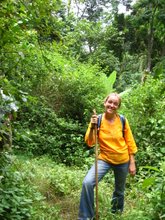


The family house in Agua Zarca, painted a bright orange matching the home in Atolinga, remains vacant but the one in Atolinga is inhabited by Tío Jaime, Tía Carmen and their children, Victor (2 yrs old) and Maria (4 yrs old), who leave one room on the ground floor and one room on the second floor open for Chavo’s parents, Don Luis and Doña Mari, or so it seems. Don Luis’s sturdy maroon Chevrolet truck, recently adorned with a rosary hanging from the mirror, is stored in the garage during their absence and the empty room or two in the house await their summer sojourn. Both homes were mentioned as places for retirement once the time came for Don Luis to stop working at the meat processing plant. One day when we visited the rancho, I think the same day we went to Temastián, he and Mari took me across the street from Tía Maria and Tío José’s home to see their home, with a wire corral fence at the start of the driveway for security and cercas or walls made of stones demarcating different rancho territories. Although they hadn’t lived here for more than twenty years, they returned to this house several times when they came to Atolinga/ Agua Zarca. This particular time they showed me the bedroom (with blankets and sheets still made up) and the yellow kitchen, including the comal built into the wall, and the fenced-in grassy area in the back of the house, which Don Luis said he hoped one day to use for horses. Clearly this place housed memories for the couple, perhaps even deeper ones than in Atolinga. This may have had something to do with the fact that Don Luis grew up on the rancho and lived across the street in what is still his father’s home. I would like to ask him more about this space and growing up here: the feeling of reconnecting to this community even though he has spent most of his adult life away from it, in the US. I would like to ask him how much he feels he has changed (Mari grew up on a rancho not far from here. Even though her mother and stepfather now live on the same street in Atolinga, she is primarily connected to Agua Zarca through her husband’s family). I would also like to explore the meanings of family - what does it mean when a woman joins her husband's family and a man his wife's? In this case, how did these two families end up living on the same street? And why did we spend most our time with the husband's family? Was it just coincidence?

1 comment:
Hi there. It was a pleasent surprise to find my blog listed in your page (colotlanenllamas), For some reason it was not possible to get to my blog from your link but it really aroused a great curiosity to know about you I havent had enough time to go throuhg your blog but it seems to be really interesting and you dont seem to be from this part of the world. Am I wrong?
I am goint to be here for quite a while. bye
Post a Comment